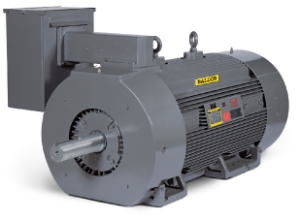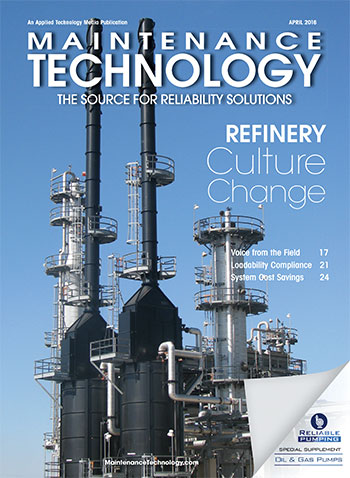Motor life depends on careful starting procedures and minimizing heat build-up.
By Jim Bryan, EASA Technical Support Specialist
The most stressful time for an electric motor is during starting, when the shaft speed is zero and the motor current is at its maximum. This condition is termed starting or locked-rotor current.
Figure 1 illustrates its effects, as well as the impact of the applied voltage on the current characteristics. As shown, the starting current is directly proportional to the voltage and inversely proportional to the speed. Although many motor-performance parameters are directly proportional to the current, the main concern here is the extra heat produced during starting. The power lost as heat (P), measured in kilowatts (kW), is proportional to the square of the current flow (I2) through a resistance (R):
P = I2R
Once a motor has successfully started and reached its load current level, its cooling circuit can dissipate the additional heat produced by the starting current. Restarting the motor before all extra heat has been dissipated, however, will add more heat (kW) to the heat already there. In that case, each subsequent start will add even more heat, raising the motor temperature until some component fails.
Guidance on starts
Depending on design, the thermal “weak link” for a squirrel-cage induction motor could be the winding, the rotor bars or the rotor shorting end rings. Thermal protection located in the windings might not be sufficient to prevent rotor bar or end ring damage. For this reason, both the National Electrical Manufacturer’s Association (NEMA) and the International Electrotechnical Commission (IEC) limit the number of times a motor can be safely started in a given amount of time, as noted below.
NEMA Std. MG 1-2011, 12.54.1: Normal Starting Conditions
Design A and B squirrel-cage induction motors having horsepower ratings given in 10.32.4 and performance characteristics in accordance with Part 12 shall be capable of accelerating, without injurious heating load, a load inertia (Wk2) connected to the motor shaft that is equal to or less than the values listed in Table 12-7 under the following conditions:
a. Applied voltage and frequency in accordance with [NEMA Standard] 12.44.
b. During the accelerating period, the connected load torque is equal to or less than a torque that varies as the square of the speed and is equal to 100% of rated-load torque at rated speed.
c. Two starts in succession (coasting to rest between starts) with the motor initially at the ambient temperature or one start with the motor initially at a temperature not exceeding its rated load operating temperature.
IEC Std. 60034-12-2007, 8.3
Motors shall be capable of withstanding two starts in succession (coasting to a rest between starts) from cold conditions, and one start from hot after running at rated conditions. The retarding torque due to the driven load is assumed to be constant and equal to rated torque, independent of speed, with an external inertia of 50% of the values given in Table 3. In each case, a further start is permissible only if the motor temperature before starting does not exceed the steady temperature at rated load.
Per the standard, the number of starts should be minimized since these affect the life of the motor.
In layman’s terms, both references mean a motor can be started twice in succession if it is at room temperature, or once if it has reached normal operating temperature. (A common shorthand expression for this is “2 cold/1 hot starts.”) Before subsequent starts can be made, the motor must cool to normal operating temperature. Rotor temperature is difficult to monitor, so it is necessary to rely on winding temperature monitors, especially for applications requiring multiple starts.
Manufacturers often limit larger motors (e.g., above 200 hp/150 kW) to nine starts per day or fewer in certain circumstances. Although manufacturers may relax these limits during commissioning to allow for alignment or balancing procedures, they should be consulted beforehand to verify that it is safe.
Note that these limits are based on the load inertias (Wk2) in NEMA Table 12-7 (or Table 20-1 for large motors) and IEC Table 3, all of which were calculated from the motor horsepower or kW rating and speed. Load inertias are important because they determine how long it will take to accelerate the load to full speed. The higher the inertia, the longer the acceleration time, and therefore the longer the motor will draw the increased current necessary for acceleration. This increased time at elevated current results in more heating of the motor.
NEMA Std. MG 10-2001, Table 7, also lists allowable starts for motors through 250 hp based on size and speed. At first glance, these limits seem to conflict with those in NEMA Stds. MG 1, but closer examination shows they are in harmony. The limits in this table are based on the following conditions:
- Applied voltage and frequency must be within the limits set in NEMA Stds. MG 1-2011, 12.44, which is a combined value of ±10% of rated voltage and frequency. For instance, an 8% voltage variation and 2% frequency variation would be a combined 10% variation.
- During acceleration, the load torque is equal to or less than a torque that varies as the square of the speed and is equal to 100% of rated torque at rated speed.
- External load inertia is equal to or less than the values listed in NEMA Stds. MG 1-2011, Table 12-7.
The allowable starts per hour is the lesser of the value in Column A or Column B, divided by the load inertia (if known). The values in Column B are nearly identical to those for the same ratings in Table 12-7 of NEMA Stds. MG 1.
In Table 12-7, the load inertia of a 100 hp, 4-pole motor is 441 lb/ft2, which is the same value given for a 100 hp, 4-pole motor in NEMA Stds. MG 10. This means for the allowable inertia, the safe starts would be one, the same as stated in NEMA Stds. MG 1, 12.54.1.
If the inertia is known and is less than the value given in Table 12-7, additional starts might be allowable. If the motor is larger than 250 hp or if the load inertia is not known, the application should use the “2 cold/1 hot start” rule unless the manufacturer is consulted.
Impacted by voltage available
As Fig. 1 shows, the starting current is affected by the amount of voltage available during start-up. When the power supply is limited, it is often necessary to employ a starting method such as reduced voltage, wye-start/delta-run or soft starting to limit the starting current and avoid voltage sag to other loads on the supply. This reduces the starting current (and therefore the rate of heating), but extends acceleration time so the extra heating lasts longer. This results in the same amount of kW being injected into the motor.
Another way to look at this is to consider the acceleration of the load as work accomplished. Whether the load is accelerated in 5 seconds or 30 seconds, the same amount of work has been accomplished, therefore heat accumulation is the same.
Conclusion
A wise motor engineer once noted that since every motor has a specific number of starts in its life, it would be better to spread them out than to use all of them the first year. To achieve the best and longest motor performance, it is important to recognize the stress imposed by starting and to limit the number of starts. Even the limits defined here represent an extreme in application. Unless that many starts are necessary, they should be avoided.
Starting stress can also be mitigated through the use of alternative applications. For example, in the case of flow demand for a pump or fan, for instance, variable-speed control may be able to provide a constant, correct flow without starting and stopping to adjust the availability of the material. With repetitive operations like punch presses or load positioning, an eddy current or fluid clutch may help.
The NEMA and IEC guidelines referenced here apply only to usual conditions. Unusual applications—such as elevators that may start 40 or 50 times per hour during peak operation—must be specifically addressed by the manufacturer’s design team. MT
Jim Bryan is a technical support specialist at the Electrical Apparatus Service Association (EASA), St. Louis, MO; 314-993-2220. EASA is an international trade association of more than 1900 firms in 62 countries that sell and service electrical, electronic and mechanical apparatus. For more information, visit easa.com.














